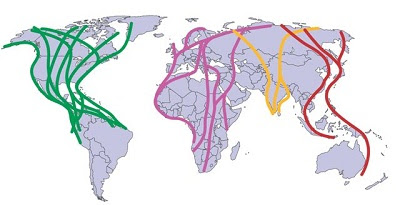 |
| A "flagged" migratory bird at Sungei Buloh. Flags are used to study these birds which travel vast distances. photo by David Li on the Sungei Buloh Engraved Flag Sightings FB page |
What are migratory birds?
Migration is a natural process. Various kinds of birds fly over very long distances (hundreds and thousands of kilometres) to find the best habitats to feed, breed and raise their young. As low temperatures make conditions at breeding sites unfavourable, migratory birds move on.
 |
| Sungei Buloh Wetland Reserve regularly monitors migratory birds that visit the Reserve. Photo by David Li with a summary of shorebird counts for 2012. |
Migratory birds are perfectly adapted to fly fast and across long distances. They have to cope with a scarcity of food, stopover sites that are shrinking in area, predators, hostile weather and the expanse of seas, huge mountains and endless deserts.
Many migratory birds have little choice when it comes to the selection of suitable areas to use. Their journey is often an exhausting one during which they go to their limits. They need access to specific sites located along their migration routes. If one of these important sites is damaged or destroyed, often it means disaster for the birds that depend on that site.
Migratory birds thus rely on a network of sites that act like 'stepping stones'. These sites are important for resting, feeding, breeding and wintering. Our wetlands and shores such as Sungei Buloh and Chek Jawa are important rest stops where migratory birds can replenish their energy and continue on their journey.
 |
| This map shows in different colours the main routes that birds use on the annual migrations. From the World Migratory Bird Day website |
With the theme “Destination Flyways: Migratory Birds and Tourism”, World Migratory Bird Day (WMBD) 2014 will highlight the links between migratory bird conservation, local community development and wildlife watching tourism around the world.
Every year, more than one billion tourists cross international borders. A thriving wildlife is a key tourism asset, and the spectacular movements of the world´s migratory birds are no exception. Properly managed, popular bird-related tourism activities such as bird watching or bird photography can serve as the foundation for a mutually beneficial relationship between people and migratory birds.
Where can you see migratory birds in Singapore?
At Sungei Buloh discover more about migratory birds, international migratory routes, and efforts at conservation and research through an exhibition, public talks, and art-and-craft sessions for the younger ones.
Although there are no special events there, you can also go to Chek Jawa to check them out on your own.
More about migratory birds
- Shore birds on wildsingapore.
- Shorebirds and waders on the Bird Ecology Study Group blog.
- More related links on the World Migratory Bird Day website.

